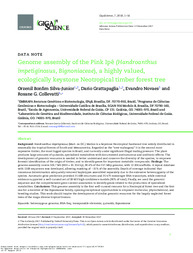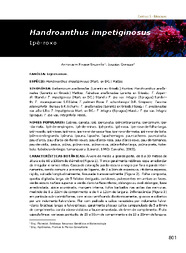Scientists develop DNA analysis to help pink ipê conservation
Scientists develop DNA analysis to help pink ipê conservation
Scientists from Embrapa Genetic Resources and Biotechnology, the Federal University of Goiás (UFG) and the Federal University of Lavras (Ufla) have developed a technological DNA analysis system for studies on the population genetics of pink ipê (Handroanthus impetiginosus). Based on the DNA genotyping through sequencing, the system is a tool that could be used in the development of biological conservation strategies for the species, and broaden the possibility of using the tree in production systems.
The genotyping technique developed in collaboration with Embrapa makes the simultaneous characterization of a large number of variations in the DNA sequences of individual trees possible. The system indicates where the variations occur in an individual's genome and the frequency with which they are found in a population. Such genetic variations are the result of processes in which hereditary traits become more common or rarer in the population. Because it is affected by modifications in the natural environment, the accumulation of variations results in genetic repertoires that can be related to organisms' land occupation.
Identifying illegal loggingAs pink ipê is practically not domesticated, molecular tools can support a faster introduction of such species in forest breeding. The technique can also help the tracking via forensic analysis of timber material, and recognize frauds through the illegal exploration of reserves. Through the genetic differentiation identified with the new technique, it is possible to infer the origin of individual trees with enough precision by statistical data analysis. |
DNA changes as adaptation
Throughout many generations, successive changes in DNA can produce genetic differentiation in the species, resulting in the establishment of populations with adaptative traits for survival and reproduction in given geographic locations. Recognizing such DNA modification processes that correlate to local adaptations is an important step for biological conservation strategies.
Pink ipê is a species that has broad regional distribution in the South and Central Americas. The tree occurs in all of the Neotropics, and in Brazil, it can be found in its North, Northeast, Midwest and Southeast regions, spreading to Bolivia, then Peru and all the way up to Mexico. However, the land occupation is sparse, which hinders comprehensive studies on the biological evolution of the species. This has restricted conservation efforts to local ecological knowledge, with a gap in clarifying groups' ability to persist in different ecosystems. Thus there is a risk that conservation or management initiatives fail to recognize land occupation patterns that ensure connections and minimize the effects of fragmentation.
Geographic origin of each tree
The genotyping system is capable of revealing the genetic differentiation between pink ipê trees from several locations that have already been analyzed by the researchers. The evidence indicates that there are different populations of the species in the Brazilian territory. In practical terms, this discovery indicates that the system can be used to determine the geographical origin of trees for the populations identified.
PublicationThe research results were described in two scientific articles published in international open-access journals. “Design and evaluation of a sequence capture system for genome-wide SNP genotyping in highly heterozygous plant genomes: a case study with a keystone Neotropical hardwood tree genome” (DNA Research) and “A genome-wide scan shows evidence for local adaptation in a widespread keystone Neotropical forest tree” (Heredity). |
Another aspect highlighted by the researchers is the discovery of that, in the biological evolution of the species, the populations shared many of the genes assessed with quite similar frequencies. This was observed in the locations studied.
These results indicate that, in spite of spatial fragmentation being notable in neotropical forests, a significant decline in the number of pink ipê individuals is not expected in the different populations. However, this does not include other causes that can lead to losses of genetic diversity, such as the predatory exploration of the species due to tree felling and forest clearing for logging gaps, common in the conventional destructive harvest practices, or even in authorized management that has with low environmental impact but is inadequate regarding the ecological and genetic traits of the species.
Moreover, through simulations involving demographic dynamics, probabilistic scenarios of environmental changes and gene responses to natural selection, the researchers warn that in some geographical regions the presence of the species can be reduced in the future.
Ipê for almost everythingIpê has been quite coveted to build decks, especially in the United States, as its wood is dense, durable and resistant. Promising results have been found in pharmaceutical industry and university laboratories, in research on the use of substances obtained from tree parts. Tests have shown a positive response against some types of cancer, however, the cytotoxicity of such substances is still a problem being investigated. |
To reach this stage of research, the scientists had already elucidated, in early 2018, the DNA sequence in the pink ipê genome. “After the DNA sequencing, a new stage of the research prioritized the development of SNPs (Single Nucleotide Polymorphisms) based molecular tools for the analysis of the genetic variation of populations, with the aim of informing biological conservation strategies and possibly adding value to its use in production systems", reports the Embrapa researcher Orzenil Silva Junior.
The scientists highlight that for the species management, it is important to assess the need for measures to protect the genetic diversity of pink ipê. They underscore that there are many studies on rainforests, but few on tropical dry forests. An example of this is highlighted in a recent paper published by Science magazine showing that only 1.2% of the total dry forest area in Brazil's Caatinga are fully protected in comparison with 9.9% of the Brazilian Amazon region.
DNA genotyping can help suitable management
The studies based on the new genotyping system have revealed the challenges that the species faces as it occupies varied environments that can interfere in the trees' survival and reproduction. "Pink ipê can establish populations in different environments within the Brazilian territory, however, such land occupation is disjoined according to the fragmentation of ecosystems in their preferential biomes", Silva Junior says.
He explains that identifying changes that affect the species' traits is essential for conservation and potential use with neotropical forest trees in management systems. "The DNA supplies a wealth of data about the relationship between the areas of occurrence of a species and the establishment of an inheritable trait, such as wood quality or the production of a chemical compound used in the industry."
"Studies using the genotyping system can bring about management guidelines for growers who are interested and help the continuity of the species in its natural environment", the scientist punctuates. However, other evidence is necessary to consider refining pink ipê management.
He stresses that there are studies indicating that pink ipê's ecological and genetic traits can hinder its sustainable management in cycles with 30-year intervals between a cut and another of trees in the same region. Genetic, ecological parameters and forestry practices thus have to be assessed to ensure that there will be enough time so that a population does not fall in decline due to disturbances caused by the exploration. The DNA analysis can contribute to all of such assessments.
Translation: Mariana Medeiros
Maria Devanir Heberlê (MTb 5.297/RS)
Embrapa Genetic Resources and Biotechnology
Press inquiries
nco.cenargen@embrapa.br
Phone number: +55 61 3448-3266
Further information on the topic
Citizen Attention Service (SAC)
www.embrapa.br/contact-us/sac/



